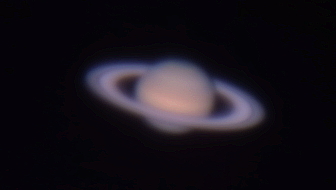
Mercury Detail Viewed, iPhone Saturn,
Aurora from Southern Arizona?, Barnard's Star?
Posted: 3 June 2013
Another pack rat from near the observatory was captured and released on Saturday, 1 June 2013. Count is now 21 live pack rats and 2 dead ones. We also removed three remaining nests (that we know of) near the observatory. I will continue to place traps at the locations of the former nests for a few more days.
Saturday night was cloudy. No observing.
The sky cleared on Sunday, 2 June 2013, and the observatory was opened at 1859 MST, 99°F. The sky was clear, with a slight breeze blowing. At 1909 MST, viewed Venus, and then Mercury, 83X. Switched to 222X on the 8" LX200-ACF and viewed Mercury. There was a really great view of the planet. I might have detected a surface detail. I upped the magnification to 364X using a different eyepiece, and the same detail was visible. I moved the object in the eyepiece to ensure it was not some artifact, and the object remained visible in the same place on the planet's disk. I checked SkySafari Pro on the iPhone for surface details and in fact, there was something at the location I was seeing it:

Mouseover the image above or tap on it if using a touchscreen device (iPad, iPhone, etc.) to see the detail observed.
I have never seen details on Mercury and it was a surprise to see something with the 8" telescope.
At 1924 MST, I set up my folding recliner chair on the observatory patio for use later while taking sky photos. I then resumed Mercury observing. The surface detail was still visible at 364X. Sunset occurred at 1930 MST. At 1932 MST, Mercury was too low for good viewing.
I next viewed Saturn 83X and 364X. The Ring and shadows were seen. While waiting for the sky to darken, I took this photo while seated in my observing chair using the D7000 DSLR with an 8mm fisheye lens:

I prepped the D7000 DSLR for sky imaging by attaching the Vello Wireless ShutterBoss Timer Remote. Once that was done, I resumed Saturn observing, 364X. At 2005 MST, four moons were visible: Titan, Rhea, Dione, and Tethys. I then mounted the iPhone 4 on the 8" telescope using the MX-1 afocal adapter. Using the iOS app FiLMiC Pro, I did some 30 second afocal videos, 444X, of Saturn. I then stacked one of the videos using Keith's Image Stacker. This is a stack of 689 frames:

At 2037 MST, I began setting up for sky photography. On the last session I did sky photography using the D7000 DSLR with a 18mm lens aimed at Polaris. I then used StarStaX to create a "star trails" image. I also created a video showing the rotation of the sky in 30 minutes. This night I repeated the sky photography, but I used an 8mm fisheye lens and did an hour's worth of imaging, starting at 2100 MST, f/5, 1 minute exposures, ISO 5000. This is the result of the 54 sky photos:

Click the above image to view a time-lapse video of the same images, showing the 60 minutes of rotation of the sky in 5 seconds.
The star trails image and the video both show a satellite "flaring". This is the frame with the flare:

The single frame above shows some horizontal green bands. The video shows the green bands moving over the one hour of the video. Could this be aurora visible from southern Arizona? With the light on the hill to the east off again this night (thanks neighbor!), the sky was really dark so maybe this was indeed aurora!
I completed sky imaging at 2200 MST. Viewed Saturn, 83X, at 2212 MST. Still four moons visible. I then connected the iPhone 4 to the 8" telescope using the GC Wi-Fi Adapter and used SkySafari Pro to GOTO Barnard's Star. This star has high proper motion, so I thought I would try to image the star field two weeks apart to see if I could show the motion. Identifying the stars shown in SkySafari using a magnification of 83X proved to be a challenge. After 20 minutes of searching, I think I was finally able to identify Barnard's Star, Magnitude +9.4. I attached the D7000 DSLR at prime focus of the 8" using the star diagonal. This 30 second, ISO 6400, unguided exposure should show Barnard's Star:

I compared the above image to the star field shown in SkySafari Pro for Mac OS X and in Voyager, but I was not successful at identifying any of the stars in the image. I will take another image in two weeks and do a "blink comparison" to hopefully identify Barnard's Star.
At 2301 MST, I began doing some Deep Sky Object (DSO) observing, 83X. Viewed Omega Centauri (globular cluster), Centaurus A (galaxy), M80 (globular cluster), M4 (globular cluster), NGC6124 (open star cluster), NGC6231 (open cluster), NGC6302 ("Bug Nebula", planetary nebula), M6 ("Butterfly Cluster", open cluster), M7 (open cluster), M107 (globular cluster), M12 (globular cluster), M10 (globular cluster), M62 (globular cluster), M19 (globular cluster), M14 (globular cluster), and NGC6633 (open cluster).
I ended observing and began closing up at 2341 MST. This was a good night and there were no Kissing Bugs seen. Removal of the pack rat nests near the observatory must have helped.
The observatory was closed at 2356 MST, 75°F.
Comments are welcome; use the Comments section below, or you can Email Me. Thanks.
Cassiopeia Observatory Home Page